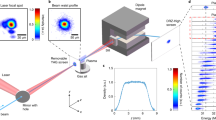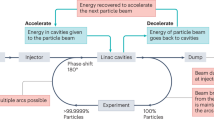Abstract
In a fixed-field alternating-gradient (FFAG) accelerator, eliminating pulsed magnet operation permits rapid acceleration to synchrotron energies, but with a much higher beam-pulse repetition rate. Conceived in the 1950s, FFAGs are enjoying renewed interest, fuelled by the need to rapidly accelerate unstable muons for future high-energy physics colliders. Until now a ‘scaling’ principle has been applied to avoid beam blow-up and loss. Removing this restriction produces a new breed of FFAG, a non-scaling variant, allowing powerful advances in machine characteristics. We report on the first non-scaling FFAG, in which orbits are compacted to within 10 mm in radius over an electron momentum range of 12–18 MeV/c. In this strictly linear-gradient FFAG, unstable beam regions are crossed, but acceleration via a novel serpentine channel is so rapid that no significant beam disruption is observed. This result has significant implications for future particle accelerators, particularly muon and high-intensity proton accelerators.
This is a preview of subscription content, access via your institution
Access options
Subscribe to this journal
Receive 12 print issues and online access
$209.00 per year
only $17.42 per issue
Buy this article
- Purchase on Springer Link
- Instant access to full article PDF
Prices may be subject to local taxes which are calculated during checkout





Similar content being viewed by others
References
Symon, K. R., Kerst, D. W., Jones, L. W., Laslett, L. J. & Terwillinger, K. M. Fixed-field alternating-gradient particle accelerators. Phys. Rev. 103, 1837–1859 (1956).
Symon, K. R. Particle Accelerator Conference 2003 452–456 (IEEE, 2003).
Machida, S. Neutrino factory design based on FFAG. Nucl. Instrum. Methods Phys. Res. A 503, 41–46 (2003).
Keil, E. & Sessler, A. M. Muon acceleration in FFAG rings. Nucl. Instrum. Methods Phys. Res. A 538, 159–177 (2005).
The ISS Accelerator Working Group, Apollonio, M. et al. J. Instrum. 4,P07001 (2009).
Keil, E., Sessler, A. M. & Trbojevic, D. Hadron cancer therapy complex using nonscaling fixed field alternating gradient accelerator and gantry design. Phys. Rev. ST Accel. Beams 10, 054701 (2007).
Peach, K. et al. International Particle Accelerator Conference 2010 112–114 (IPAC’10 Organizing Committee, 2010).
Cywinski, R. et al. Towards a dedicated high-intensity muon facility. Physica B 404, 1024–1027 (2009).
Tanigaki, M et al. European Particle Accelerator Conference 2006 2367–2369 (EPS-AG, 2006).
Aiba, M. et al. European Particle Accelerator Conference 2000 581–583 (EPS-AG, 2000).
Mills, F. 4th International Conference Physics Potential and Development of μ+μ− Colliders, Transparency Book 693–696 (UCLA, 1997).
Johnstone, C. 4th International Conference Physics Potential and Development of μ+μ− Colliders, Transparency Book 696–698 (UCLA, 1997).
Machida, S. & Kelliher, D. J. Orbit and optics distortion in fixed field alternating gradient muon accelerators. Phys. Rev. ST Accel. Beams 10, 114001 (2007).
Johnstone, C., Wan, W. & Garren, A. Particle Accelerator Conference 1999 3068–3070 (IEEE, 1999).
Berg, J. S. Snowmass 2001, SLAC-R-599, http://www.slac.stanford.edu/econf/C010630, T503 (SLAC, 2001).
Johnstone, C. & Koscielniak, S. Snowmass 2001, SLAC-R-599, http://www.slac.stanford.edu/econf/C010630, T508 (SLAC, 2001).
Berg, J. S. European Particle Accelerator Conference 2002 1124–1126 (EPS-AG, 2002).
Koscielniak, S. & Johnstone, C. Particle Accelerator Conference 2003 1831–1833 (IEEE, 2003).
Johnstone, C. & Koscielniak, S. FFAGs for rapid acceleration. Nucl. Instrum. Methods Phys. Res. A 503, 445–457 (2003).
Koscielniak, S. & Johnstone, C. Mechanisms for nonlinear acceleration in FFAGs with fixed rf. Nucl. Instrum. Methods Phys. Res. A 523, 25–49 (2004).
Berg, J. S. Minimizing longitudinal distortion in a nearly isochronous linear nonscaling fixed-field alternating gradient accelerator. Phys. Rev. ST Accel. Beams 9, 034001 (2006).
Machida, S. Resonance crossing and dynamic aperture in nonscaling fixed field alternating gradient accelerators. Phys. Rev. ST Accel. Beams 11, 094003 (2008).
Keil, E. Electron model: Lattice and performance. Nucl. Phys. B. Proc. Suppl. 155, 323–324 (2006).
Barlow, R. et al. EMMA—The world’s first non-scaling FFAG. Nucl. Instrum. Methods Phys. Res. A 624, 1–19 (2010).
Wheelhouse, A. et al. International Particle Accelerator Conference 2010 3999–4001 (IPAC’10 Organizing Committee, 2010).
Berg, J. S. The EMMA main ring lattice. Nucl. Instrum. Methods Phys. Res. A 596, 276–284 (2008).
Kalinin, A., Smith, R. & McIntosh, P. A. International Particle Accelerator Conference 2010 1134–1136 (IPAC’10 Organizing Committee, 2011).
Saveliev, Y. et al. International Particle Accelerator Conference 2010 2350–2352 (IPAC’10 Organizing Committee, 2010).
Muratori, B. D., Smith, S. L., Tzenov, S. I. & Johnstone, C. European Particle Accelerator Conference 2008 3386–3888 (EPS-AG, 2008).
Smith, S. L. 19th International Conference on Cyclotrons and their Applications 390–394 (Institute of Modern Physics (IMP), 2010).
Koscielniak, S. & Craddock, M. K. European Particle Accelerator Conference 2004 1138–1140 (EPS-AG, 2004).
Laskar, J., Froeschlé, C. & Celletti, A. The measure of chaos by the numerical analysis of the fundamental frequencies. Application to the standard mapping. Physica D 56, 253–269 (1992).
Acknowledgements
We greatly appreciate the assistance of the Technology Department at STFC Daresbury Laboratory during the design and construction of EMMA. Our work is supported by the BASROC/CONFORM project (the UK Basic Technology Fund) under Engineering and Physical Sciences Research Council (EPSRC) Grant No. EP/E032869/1, the UK Neutrino Factory project under Particle Physics and Astronomy Research Council (PPARC) Contract No. 2054, Science and Technology Facilities Council (STFC), National Sciences and Engineering Research Council of Canada (NSERC) Grant No. SRO 328338-05 and the US Department of Energy under Contract No. DE-AC02-98CH10886 and DE-AC02-07CH11359.
Author information
Authors and Affiliations
Contributions
All authors contributed extensively to the work presented in this paper.
Corresponding author
Ethics declarations
Competing interests
The authors declare no competing financial interests.
Rights and permissions
About this article
Cite this article
Machida, S., Barlow, R., Berg, J. et al. Acceleration in the linear non-scaling fixed-field alternating-gradient accelerator EMMA. Nature Phys 8, 243–247 (2012). https://doi.org/10.1038/nphys2179
Received:
Accepted:
Published:
Issue Date:
DOI: https://doi.org/10.1038/nphys2179
This article is cited by
-
A beamline to control longitudinal phase space whilst transporting laser wakefield accelerated electrons to an undulator
Scientific Reports (2023)
-
Experimental study on dipole motion of an ion plasma confined in a linear Paul trap
Hyperfine Interactions (2015)



